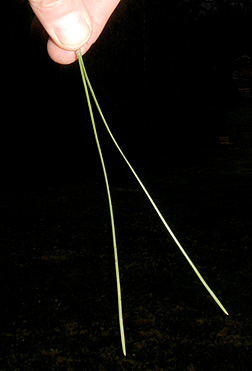

Red pine is one of the most extensively planted trees in the northern U.S. and Canada. It is used for windbreaks, erosion control, and wood products. Red pine needles are 4 to 6 inches long, and occur in bundles of 2.
Light ![]()
Red pine is less shade tolerant than many common associates. Clearcut, seed-tree, and shelterwood methods are recommended.
Water
![]()
![]()
![]()
![]()
![]()
![]()
Red pine is most often found on sandy acid soils and on burned-over areas. Red pine was widely planted in the Northeast by the CCC.
Growth
![]()
Size
![]()
A medium size tree reaching up to 90 feet tall, with oval crown and a clear bole. Foliage is tufted, resembling a fox tail.
Timber Value ![]()
Red pine is used for lumber, piling, poles, cabin logs, railroad ties, posts, mine timbers, pulpwood, and fuelwood.
Wildlife Value ![]()
Red pine provides cover, nesting sites, and food for many birds and other animals.
Attracts birds, deer, porcupine, snowshoe hare
Fun Facts
The wood is utilized for construction and pulpwood. Red pine has been widely planted for land reclamation. Natural stands declined following heavy harvesting and lack of seed trees in the early 1900's. Red pine is the state tree of Minnesota.
Latin Meaning
Pinus: Latin name for pine from Greek "pitus" /
resinosa: resinous
Home - I.D. Fact Sheet - USDA Silvics Manual - Additional Silvics
Landowner Factsheets © 2004 Virginia Tech Forestry Department, all rights reserved. Text, images, and programming by: Dr. Jeff Kirwan, Dr. John R. Seiler, John A. Peterson, Edward C. Jensen, Guy Phillips, or Andrew S. Meeks.